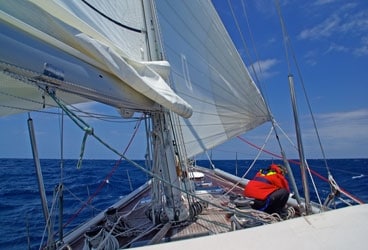
heaving to 368
It was blowing southwest about 12 to 15 knots when we left Bermuda for Newport, Rhode Island. Though the conditions were perfect then, we were anticipating that a cold front would soon arrive, generating strong headwinds. The next day, the wind was predicted to shift back to the southwest again, giving us a reach across the Gulf Stream and into Newport. I normally don’t depart with strong headwinds in the immediate forecast, but this particular season, there seemed to be only three-day weather windows for our four-day trip, so we had to bite the bullet.
At noon on the second day-a little more than 20 hours out of Bermuda-the sky in the northwest turned dark gray, and the front moved through with shifty winds and heavy rain. We motorsailed into building breeze from the northwest-the direction we wanted to go. By 1600, the breeze was up to 30 knots, and the waves were starting to get big under clearing skies. Our speed was down to 3 or 4 knots, and we were taking green water over the bow. We were looking at a really uncomfortable night’s slog before the anticipated wind shift back to the southwest the next morning.
So we hove to, and the motion became slow and gentle, with the boat rising easily to each wave. Holding a cup of tea, I watched the mountainous seas roll by harmlessly.
We had about 25 percent of the jib rolled out and backed, that is, sheeted tight to the wrong side of the boat. The main had three reefs in it and was sheeted in far enough to keep the bow about 60 degrees off the wind. The helm was lashed down as if trying to force the boat to tack against the backed jib.
The easiest way to heave to is get on the opposite tack from the one on which you want to end up, sheet in the jib, and then tack. Then you simply change your mainsail trim to fine-tune your angle to the breeze; the closer the main is sheeted, the closer your bow will point to the wind. I find that having the bow about 60 degrees off the breeze and the waves often works best.
Many cruisers forget that given enough sea room, they always have the option of heaving to in even marginal weather. Too often, they get caught up in the idea that they must adhere to a time schedule. My father always told me, “Sailboats don’t have ETAs,” and it’s true. If you carry on regardless of the weather, it’s easy to get into trouble, either by damaging the boat or the crew. Why not simply stop and wait it out? Sometimes after a few days of rough weather on a passage, I’ll simply heave to for an hour just so we can have a meal in comfort.
Near the end of his fifth transatlantic delivery, in June 2008, associate editor Andrew Burton hove to in a 45-knot mistral and successfully rebedded a leaking foredeck hatch.








